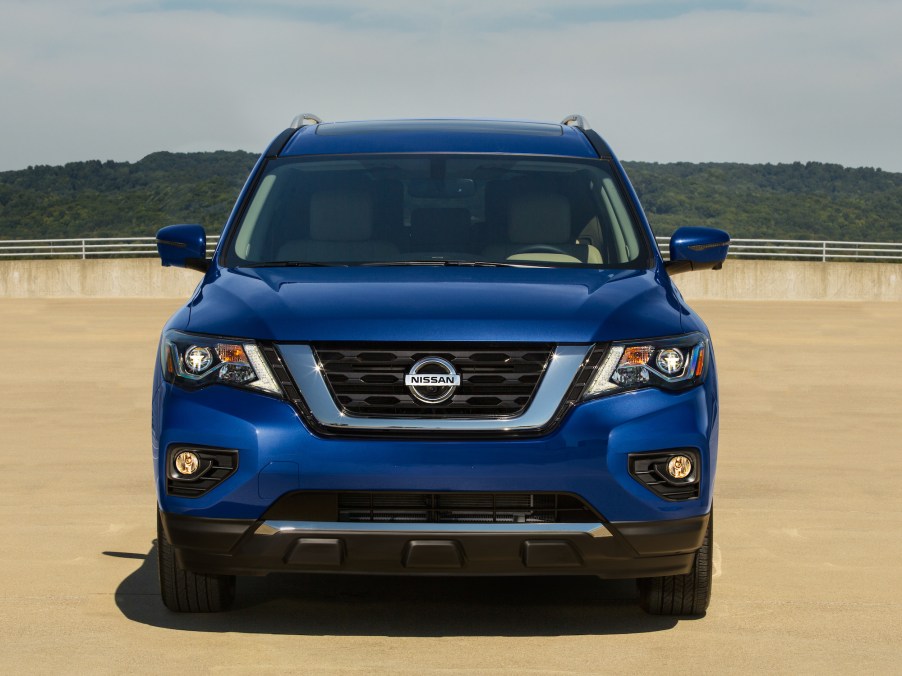
The Nissan Pathfinder Has Never Been a Favorite of Critics
There are plenty of great SUVs on the market, but the Nissan Pathfinder doesn’t seem to be one of them. Once a rugged truck, the current Pathfinder is now just a more stylish version of the extinct Nissan Quest minivan. Still, the Pathfinder has a capable V6 engine and can tow more than many of its rivals.
Nissan also claims the available four-by-four drivetrain allows the midsize crossover to go off-roading with confidence. However, the Pathfinder still gets rock-bottom scores from critics.
The Nissan Pathfinder trends downward
Consumer Reports has consistently given the Nissan Pathfinder low scores, even after a few redesigns. It has always received the lowest reliability score, though it seems to have slightly improved in the past two model years. Its owner satisfaction score remains at rock-bottom: Only 47 percent of owners say they’d buy another Pathfinder.
Although owners seem to enjoy the SUV’s overall performance, most don’t think the Nissan Pathfinder is a good value. And many owners don’t like the Pathfinder’s interior, which U.S. News also scored poorly. The Pathfinder occupies the low end of that site’s SUV ratings. It ranks only slightly better than the now-discontinued Dodge Journey.
Why don’t critics like the Nissan Pathfinder?
On paper, the Nissan Pathfinder looks like it would be a good SUV. It comes standard with a 2.5-liter V6 engine capable of 284 hp and 259 lb-ft of torque. It’s paired with a continuously variable transmission, which Consumer Reports found surprisingly quiet during a road test.
All-wheel drive is optional, but CR said it doesn’t always supply enough power to all four wheels. Testers also found that the Pathfinder’s real-world gas mileage numbers were well below reported estimates. The EPA rates it for 23 mpg combined city/highway, but CR could get only 18 mpg.
Testers also didn’t feel confident behind the Nissan Pathfinder’s heavy steering wheel. Although you don’t have to worry about the wheels leaving the pavement, the Pathfinder doesn’t handle corners with any grace. CR’s testers noted the brakes are decent, but the stability control kicks in with an obtrusive jolt.
The front seat is incredibly spacious. However, drivers might have a hard time seeing past the second-row cushions. The roof pillars also thicken out at the rear, but front visibility is excellent. The Nissan Pathfinder can seat up to seven, but the second row is more comfortable with only two adults.
CR also cautions that the third row is too cramped to hold anyone comfortably besides smaller passengers. The seat cushions for the two back rows are also firm and lack much thigh support. However, testers appreciated that third-row access is easy thanks to a forward-sliding second-row seat. Cargo space is also plentiful in the Pathfinder.
Although the interior is decently accommodating, it looks outdated compared to its rivals. The dashboard lacks any stylish accents, and confusing buttons litter the center stack. The infotainment screen doesn’t have the best resolution either. And there’s no smartphone integration, disappointing for a $31,000-plus 2020 model.
SUVs that provide better value
For the same price, you might be better off purchasing a Hyundai Palisade. Its interior is roomier and more upscale than the Nissan Pathfinder. Plus, it has standard smartphone integration. It also gets better gas mileage than the Pathfinder and scored an excellent predicted reliability rating from Consumer Reports.
If you want better handling, the Mazda CX-9 is also a great option. It’s a little more expensive than rivals, but it’s fun to drive and boasts an interior bordering on luxury. And the Kia Telluride, a critical darling, provides a perfect balance of great handling, a plush ride, and a stylish interior.



